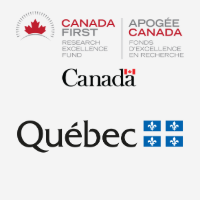Through the COVID-19 pandemic and the subsequent creation of an mRNA vaccine, we saw firsthand the remarkable potential of messenger RNA (mRNA) as a therapeutic platform. What seemed like a simple prick in the arm, was in fact, a sophisticated set of instructions delivered to cells – teaching them to recognize, respond to, and fight the virus.
And while the power of mRNA provided a solution to the global pandemic, it is not without its limitations. Its rapid degradation in the body, the short duration of protein production and the potential of triggering responses from the immune system are a few of the challenges of mRNA therapeutics. Professor Masad Damha and his co-investigator, Professor Sidong Huang, are working to unlock the full potential of mRNA with their D2R-funded research, titled “Engineering a Circular RNA platform for Cap-dependent Translation”. Their research aims to address the limitations of traditional mRNAs by exploring a more stable alternative – circular RNA (circRNA) – and unlocking the potential to create more durable, targeted, and versatile treatments beyond vaccine technology.
The next step for mRNA
Traditional mRNA molecules are linear strands that are rapidly broken down in the body by enzymes called nucleases. “This rapid degradation limits the duration of their effect and the tunability for genetic medicine.” Prof. Damha explains. To overcome this challenge, Prof. Damha’s research is focused on further exploration of circRNA, which is resistant to nucleases, and therefore significantly more stable. Unlike the linear mRNA, circRNA forms a loop shape which protects it from rapid degradation. This improved strength and durability could make RNA therapies more effective over longer periods – reducing dosage frequency and improving consistency.
“The goal is to synthesize messenger RNA chemically rather than enzymatically, thus providing more flexibility for introducing modifications in the mRNA strand.” Prof. Damha adds.
This chemical synthesis of circRNA has the potential to extend the longevity of the mRNA and reduce unwanted immune responses within the human body and the key to transforming the future of mRNA-based therapies lies in its flexibility. Researchers rely on tunability to precisely control how much protein is made, how long it lasts, and where it’s produced in the body—adding a layer of precision to treatment.
Additionally, current methods exploring circRNAs for protein production rely on the presence of an internal RNA sequence called “the Internal Ribosome Entry Site (IRES)”, a discovery made by McGill’s own Professors Nahum Sonenberg and Jerry Pelletier. However, IRES sequences can trigger immune responses and slow down protein production. Taking that into consideration, Prof. Damha’s research proposes the development of RNA lariats –circular RNAs with a tail. This tail allows for the addition of a cap, which further stabilizes the RNA structure. The cap structure is a critical feature of linear cellular mRNAs, enabling efficient protein translation without triggering an immune response. The Damha and Huang research teams are also developing chemical methods to prepare linear “mini mRNAs”. When translated, these mRNAs produce peptides (‘neoantigens’) which train the immune system to recognize and attack cancer cells. Their chemical methods have so far produced mRNA that are over 200 nucleotides in length, a difficult feat to achieve with current methods. The group is also introducing site-specific modifications to improve stability and translation of these mRNAs.
Messenger RNA (mRNA) that is more stable, longer lasting and tunable holds great promise for developing stronger, more effective and more targeted treatments for genetic disorders and cancers. This is a crucial step toward advancing and personalizing genetic medicine.
Fundamental science, lasting impact
As many in the McGill community know, the contributions of the late Professor Jerry Pelletier were significant to the research community and his impact remains present in those who worked with him, like Prof. Damha. “The genius behind this project is our late colleague Jerry Pelletier who left us way too soon.” Prof. Damha shares “He was and continues to be the inspiration of many of my colleagues here.”
As one of Canada’s most distinguished RNA biologists, Professor Pelletier played a key role in shaping the vision for D2R and how it brings together diverse fields of research and expertise across McGill. The D2R Initiative and its growing impact stand as part of his legacy—one defined not only by scientific excellence, but also by collaboration and mentorship.
For Prof. Damha, that legacy extends beyond scientific outcome, as it also includes training opportunities for students working alongside researchers on D2R funded projects. “D2R is just the best thing that has happened to McGill in many years.”
Both Prof. Damha and Prof. Huang prioritize providing trainees with an individualized mentorship approach. From their backgrounds to their career aspirations, they consider it all to best support their students. The investment in students, is an investment in the future. “I am privileged to have the opportunity to work with them,” says Prof. Damha. “They are our next generation of scientific leaders.”
Foundations for the future
Beyond the challenges and scientific curiosity lies a deeper motivation: Prof. Damha’s passion to make a meaningful impact on human health.
As he puts it, “it comes down to doing some good for humankind.” Fundamental research like Prof. Damha’s project lays the foundation for further innovation. One of his goals is to develop tools that open new possibilities to improve health and save lives. So, while, this project might not be directly focused on discovering the “magic bullet” to cure cancer, he hopes this work will help advance RNA research so that one day his work could provide the missing piece for a future researcher striving toward that very goal.
In the photo, from left to right: Dr. Francis Robert (Senior Research Associate), Prof. Sidong Huang (Associate Professor), Prof. Masad Damha, Zhengrui (MSc candidate), Zidi Lyu (PhD candidate), and Nicola Beauparlant (BSc candidate).


